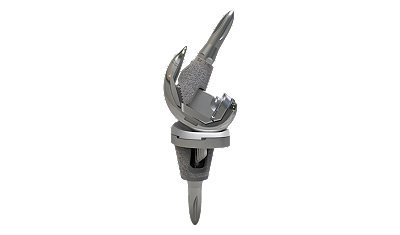Triathlon Revision
Knee System
The Triathlon Revision Knee System is designed to provide stability and alignment of the revision components while maintaining simplicity in the OR.

Revisions. Simplified.
The Triathlon Revision Knee System is designed to provide simplicity in achieving joint stability and fixation. The system provides patented implants and instrumentation designed to properly locate the joint line and balance the knee consistently1, as well as reaming instrumentation to allow for accurate preparation of metaphyseal fixation.2-5
Joint line
Triathlon Total Stabilized (TS) is designed to facilitate joint line restoration, which aids in reducing issues such as decreased motion, decreased extensor strength, anterior knee pain and midflexion instability.2,18
Stability
The anatomic location of the Triathlon TS femoral boss reduces the need for offsetting to provide flexion stability6; additionally, Triathlon TS’s insert geometry allows for varus/valgus stability with rotational freedom.6,7
Fixation
Cone preparation and implants provide an intimate, line-to-line fit, which allows for accurate Triathlon Tritanium Cone Augment positioning and initial fixation.5,8,9,10,11
Balance
Triathlon Revision features a single radius, designed to restore the knee’s single centre of rotation during active flexion, allowing for constant ligament balance and enhanced stability in flexion.12-17
References:
- Triathlon Revision Surgical Protocol. TRITS-SP-1 Rev-3_30304, 2015
- Mahoney, O et al. Modular femoral Offset Stems Facilitate Joint Line Restoration in Revision Knee Arthroplasty Clin. Orthop. 446, 2006: pp. 93-98
- Hitt, K et al. Use of Augments Provides Greater Functional Outcomes than Augments with Offset Adapters In Revision TKR. ISTA 2013
- Masini, M et al. The Joint Reduction Method of Revision Total Knee Arthroplasty. Orthopedics. 2004; 27-8: 813-816
- Triathlon Revision Surgical Protocol. TRITS-SP-2 Rev-5_30289, 2016.
- Stryker Technical Report Research and Development. Varus/Valgus Constraint Testing of the Triathlon TS Knee. RD-06-121
- Stryker Technical Report R&D. Range of Constraint Testing of Triathlon TS Plus Knee. RD-06-124
- Tibial Bone Prep Tolerance Analysis. Doc #A0004385. Project #195725
- Femoral Bone Prep Tolerance Analysis. Doc #A0004384. Project #195725
- Stryker Technical Report R&D. Micromotion of Triathlon Tibial Cone Augment Constructs. RD-14-050
- Stryker Technical Report R&D. Triathlon Tritanium Femoral Cone Augment Micromotion. RD-14-049
- Designed to maintain collateral ligament stability throughout the range of motion. Stryker Initiated Dynamic Computer Simulations of Passive ROM and Oxford Rig Test, Stephen Piazza, 2003
- Cook L, Klika A, Szubski C, Rosneck J, Molloy R, Barsoum W. Functional Outcomes Used to Compare Single Radius and Multi-radius of Curvature Designs in Total Knee Arthroplasty J Knee Surg 2012;25:249–254
- Larson et al. Single-Radius Total Knee Implant Outperforms Multi-Radius Design in Level Walking Kinematics and Kinetics. ISTA 2013 Meeting. Poster 2289
- Shimizu N, et al. In Vivo Movement of Femoral Flexion Axis of a Single-Radius Total Knee Arthroplasty. J Arthroplasty, 2014
- Iwaki H, Pinskerova V, Freeman MAR. Tibiofemoral movement 1: the shapes and relative movements of the femur and tibia in the unloaded cadaveric knee. J Bone Joint Surg [Br] 2000; 82-B: 1189-95
- Hollister, A., The Axes of Rotation of the Knee, Clinical Orthopaedics and Related Research. Number 290 pp. 259-268
- Samson, AJ, et al., “Optimizing posterior condylar offset and joint line restoration in revision total knee arthroplasty using a contemporary implant system.” Techniques in Orthopaedics 2018, epub ahead of print
TRITS-WC-3_30907
